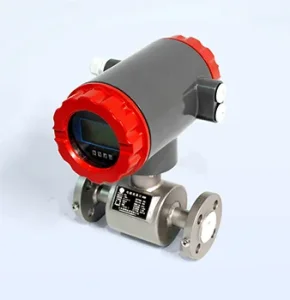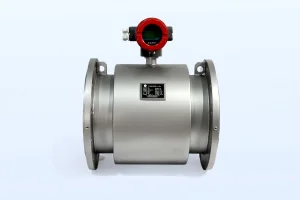
Meteri di flusso magnetici Usare un trucco ordinato chiamato legge di Faraday per determinare quanto velocemente il liquido si muove in un tubo. Questa legge misura il segnale elettrico quando un liquido scorre attraverso un campo magnetico. Il liquido deve condurre elettricità, di solito almeno 5 µS/cm. Il contatore ha un campo magnetico e piccoli sensori, chiamati elettrodi, per catturare questi segnali. Questi mostrano quanto velocemente il liquido va. Il contatore utilizza rivestimenti duri, come PTFE o gomma, e elettrodi forti, come Hastelloy, per affrontare i liquidi grezzi. Le scatole intelligenti chiamate trasmettitori trasformano i segnali in dati di facile lettura. Meteri di flusso magnetici sono fantastici per acqua, acque reflue o impianti chimici. Sono esatti, non richiedono molta fissazione e si adattano bene ai sistemi di controllo. Per i migliori risultati, è necessario impostarli correttamente, con una buona messa a terra, una corretta direzione del tubo e sezioni di tubo dritte.
Meteri di flusso magnetici dipendere da un'idea fresca: la legge di Faraday sull'induzione elettromagnetica. Questo dice che un liquido che trasporta elettricità crea una minuscola tensione quando passa attraverso un campo magnetico. Il liquido è come un filo in movimento. Il campo magnetico attraversa il tubo e gli elettrodi sui lati afferrano la tensione. Questa tensione corrisponde alla velocità con cui il liquido si muove. Per ottenere il flusso, moltiplicare la velocità per la dimensione del tubo. Questo rende contatori di flusso magnetici super affidabile per il controllo del flusso.
Il liquido deve trasportare elettricità per che questi contatori funzionino. Solo i liquidi che conducono bene fanno una tensione sufficientemente forte per misurare correttamente. Se la conduttività del liquido è troppo bassa, come sotto i 5 µS/cm, il segnale è troppo debole. Quindi... contatori di flusso magnetici sono ottimi per l'acqua o cose simili, ma non per oli o acqua super pulita. Alcuni contatori speciali possono gestire liquidi con meno conduttività, ma questi non sono comuni.
Il campo magnetico deve essere costante e liscio. Le bobine intorno al tubo fanno questo campo. Un campo solido significa che la tensione viene solo dal movimento del liquido, non dalle oscillazioni del campo. Ciò rende le misurazioni oneste, anche se il liquido scorre disordinatamente.
Gli elettrodi si riposano all'interno del rivestimento del tubo per raccogliere la tensione dal liquido in movimento. In una misuratore di flusso magneticoLa velocità del liquido deriva dalla tensione, dallo spazio tra gli elettrodi e dalla potenza del campo magnetico. Materiali duri, come Hastelloy, fermano la ruggine e mantengono i segnali chiari. Posizionandoli con cura evita il rumore di altre cose elettriche, quindi il segnale mostra il flusso reale.
Il tubo di flusso all'interno del contatore deve resistere a liquidi duri senza rottura. I rivestimenti come PTFE, PFA o gomma sono scelti per corrispondere al liquido, come acidi forti o fanghi grossi. Un buon rivestimento mantiene il contatore in funzione senza problemi per anni.
Ogni rivestimento si adatta a un lavoro diverso. PTFE combatte le sostanze chimiche dure. La gomma dura gestisce liquidi grezzi e granulosi. Le rivestimenti in ceramica funzionano per liquidi molto caldi. Scegliere il rivestimento sbagliato può rovinare l'accuratezza o rompere il contatore nel tempo.

Puoi scegliere modelli come il Flowmeter magnetico DN15 a DN300 da ChenShuoQuesti funzionano per un sacco di lavori, da piccoli tubi a enormi sistemi idrici della città. Sono fatti per gestire tutti i tipi di compiti facilmente.

Il modo in cui gli elettrodi sono impostati cambia quanto bene il contatore catturi i segnali. Una configurazione equilibrata riduce gli errori causati da flussi irregolari. Ciò mantiene il contatore stabile, anche se il liquido gira o si fretta.
Per i liquidi grezzi, come quelli con sostanze chimiche o bit solidi, elettrodi fatti di cose come Hastelloy o platino sono migliori. Gli elettrodi di lavaggio smettono di accumularsi e rimangono puliti, anche con liquidi sporchi.
I trasmettitori catturano i segnali degli elettrodi e li trasformano in informazioni utili. Utilizzano la matematica intelligente per eliminare il rumore e assicurarsi che i dati siano corretti.
Circuiti speciali nel trasmettitore bloccano picchi di segnale indesiderati. I convertitori analogico-digitale rendono i dati chiari e precisi, cosa importante per luoghi come la medicina o le fabbriche alimentari.
I nuovi trasmettitori hanno trucchi puliti come la fissazione automatica della deriva del segnale e il controllo della precisione in molti punti. Questi aiutano il contatore a funzionare bene, anche se le condizioni cambiano. ChenShuodi Flowmeter magnetico I sistemi hanno queste caratteristiche intelligenti.
Un misuratore di flusso magnetico può gestire un sacco di liquidi, anche sporchi, spessi o acidi. Ma se il liquido trasporta appena elettricità, come l'acqua super pura, potrebbe essere necessario metodi speciali per ottenere buone letture.
Alcune aziende, come ChenShuorealizzare sistemi con eccitazione a doppia frequenza o altri modi per misurare liquidi a bassa conduttività. Questi permettono al contatore di lavorare in posti difficili.
L'alto calore può deformare la forma del rivestimento e una forte pressione potrebbe piegare elettrodi o tenute. I trasmettitori intelligenti utilizzano sensori per risolvere questi problemi e mantenere le letture vere.
Alcuni progetti utilizzano l'isolamento per proteggere il contatore dal calore. Altri dispongono di software per regolare i cambiamenti di temperatura, in modo che il contatore rimanga affidabile in ambienti caldi.
Se il tubo è impostato in modo sbagliato, bolle d'aria o sporco possono interferire con gli elettrodi. Una buona messa a terra impedisce all'elettricità errata di rovinare le letture. Gli elettrodi toccano il liquido per controllarne il flusso.
Utilizzare anelli di messa a terra per tubi non metallici. Mantenere il contatore lontano da cose come unità a frequenza variabile a meno che non siano schermate. Eseguire cavi di segnale lontano dalle linee elettriche per ridurre il rumore.
Per far scorrere il liquido senza problemi, è necessario 5-10 diametri di tubo di tubo retto prima del contatore e 3-5 diametri dopo di esso.
Le fabbriche utilizzano regole come ISO o OIML per impostare i contatori con strumenti esatti. In campo, i gadget portatili controllano il contatore senza fermare il lavoro.
La taratura tracciabile mostra che il contatore segue le regole durante le ispezioni. Inoltre individua i problemi in anticipo, in modo da poterli risolvere prima che causino problemi.
Moderno contatori di flusso magnetici controllare se stessi con strumenti come test di elettrodi e controlli della bobina. Puoi vederli a distanza per conoscere le condizioni del contatore. Senza parti mobili, questi contatori richiedono poca cura.
Protocolli come HART®, Modbus® e Profibus® consentono al contatore di collegarsi ai sistemi di controllo. Questo fornisce dati in tempo reale e traccia le prestazioni passate.
Scegli contatori con trasmettitori wireless e dashboard cloud. Questi ti permettono di controllare come sta andando il contatore da qualsiasi parte e indovinare quando ha bisogno di riparazione.
In impianti di reflue, questi contatori gestiscono liquidi sporchi con solidi o spessore cambiante. Sono perfetti per monitorare il flusso d'acqua sotto regole rigorose.
Gli impianti chimici utilizzano liquidi duri ad alte temperature. I contatori richiedono rivestimenti speciali, elettrodi e coperture sicure per aree a rischio. ChenShuo ha opzioni che puoi personalizzare per questi lavori.
I contatori igienici con rivestimenti approvati dalla FDA funzionano per sistemi puliti in loco. Salvano i registri dei lotti per soddisfare le norme sulla sicurezza alimentare.
Se vuoi essere forte, fiducioso contatori di flusso magnetici, Co. dello strumento di Shandong Chenshuo, Ltd offre una vasta gamma per compiti difficili come il trattamento dell'acqua, sistemi energetici, HVAC o dosaggio chimico. I loro contatori mescolano costruzioni robuste con elettronica intelligente. Il loro team di supporto è sempre pronto ad aiutare per telefono o e-mail, indipendentemente da dove si trova.
Q1: I flussimetri magnetici possono misurare fluidi non conduttivi come l'olio?
R: No. Meteri di flusso magnetici hanno bisogno di liquidi che trasportano elettricità. Gli oli o l'acqua super pura non forniscono sufficiente segnale per misurare.
Q2: Ho bisogno di manutenzione frequente con questi dispositivi?
R: Non molto. Senza parti mobili, a misuratore di flusso magnetico dura a lungo con poca fissazione rispetto ad altri contatori.
Q3: È possibile installare questi contatori verticalmente?
R: Sì. Le impostazioni verticali funzionano se si seguono le regole di messa a terra e lunghezza del tubo. A volte possono anche impedire che lo sporco si accumuli.